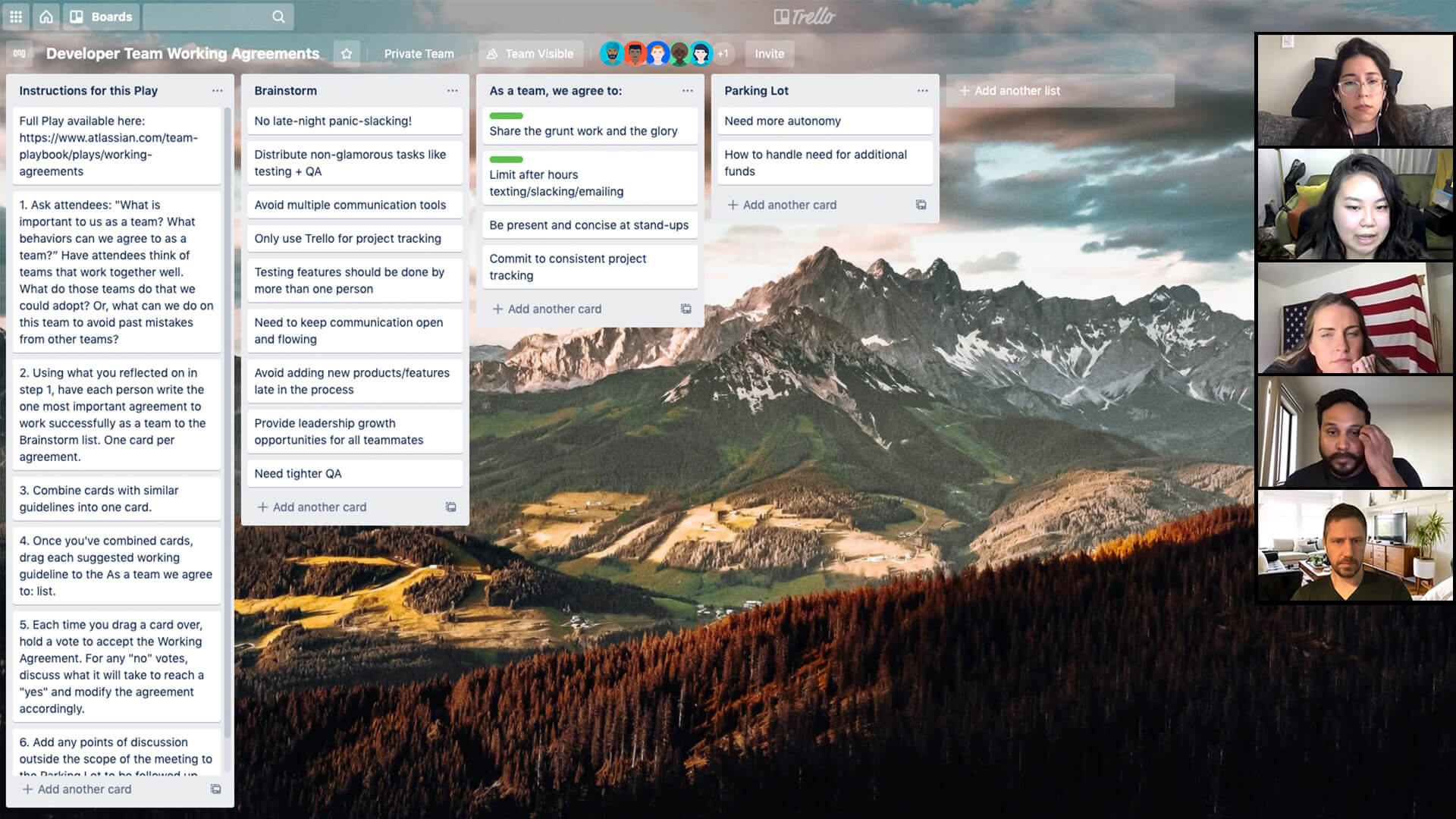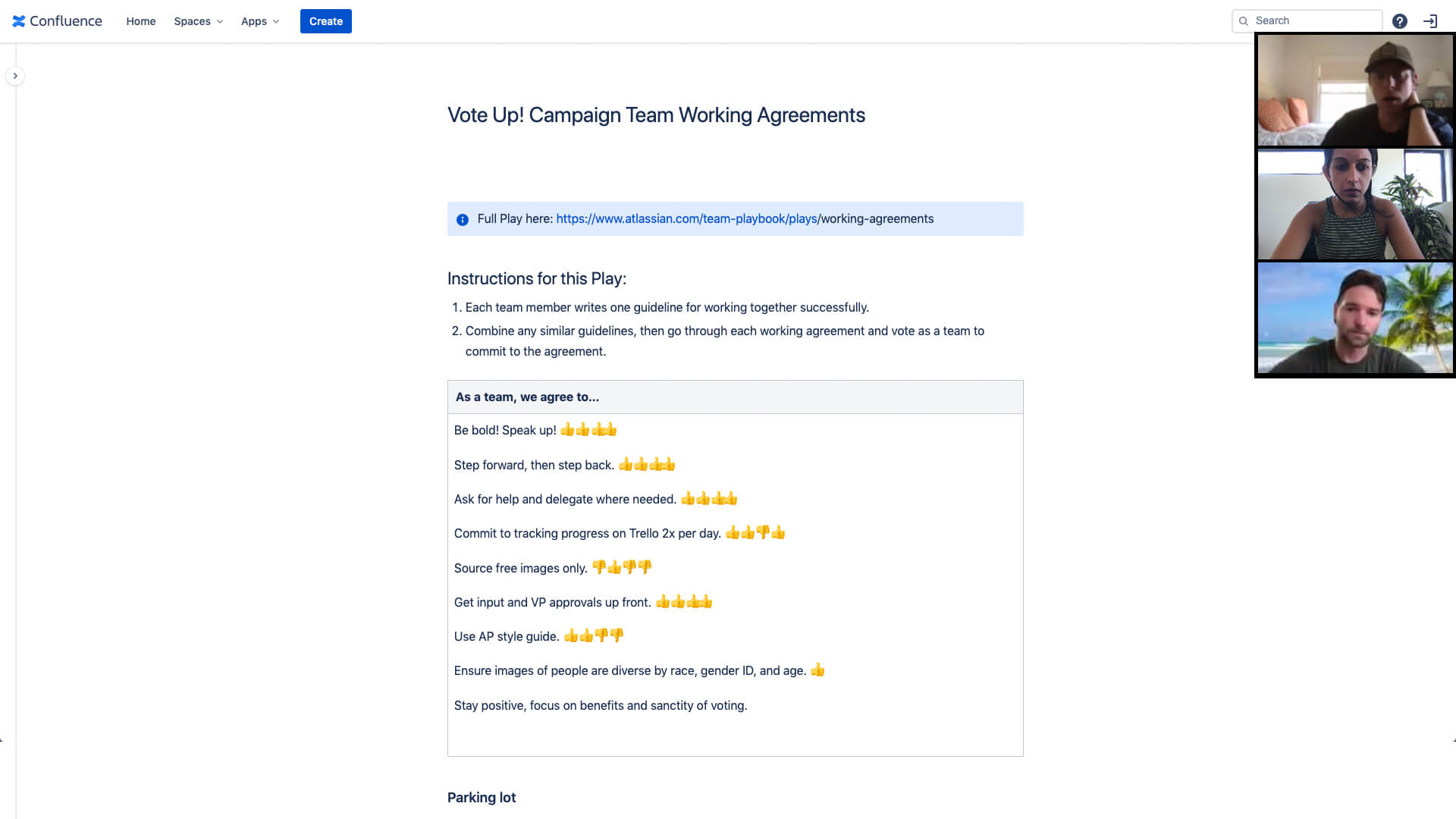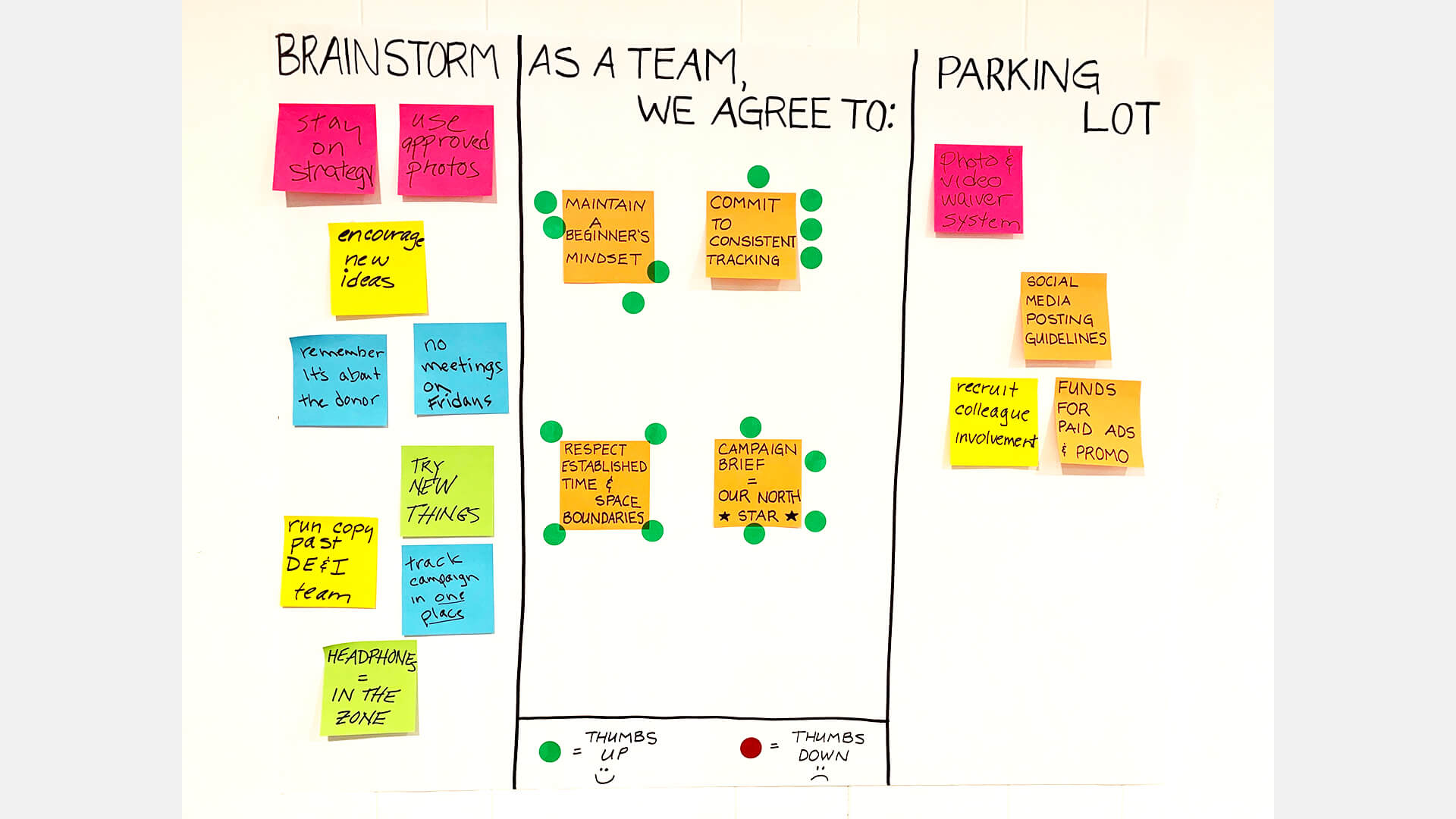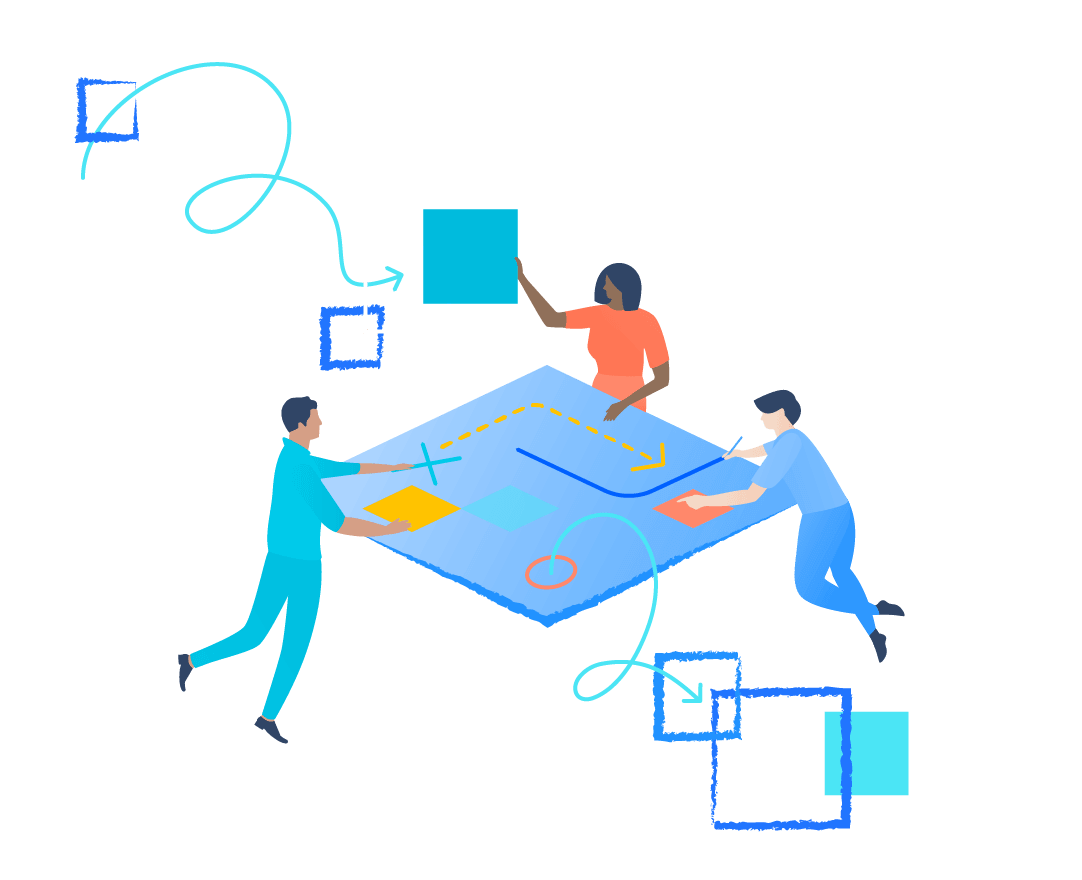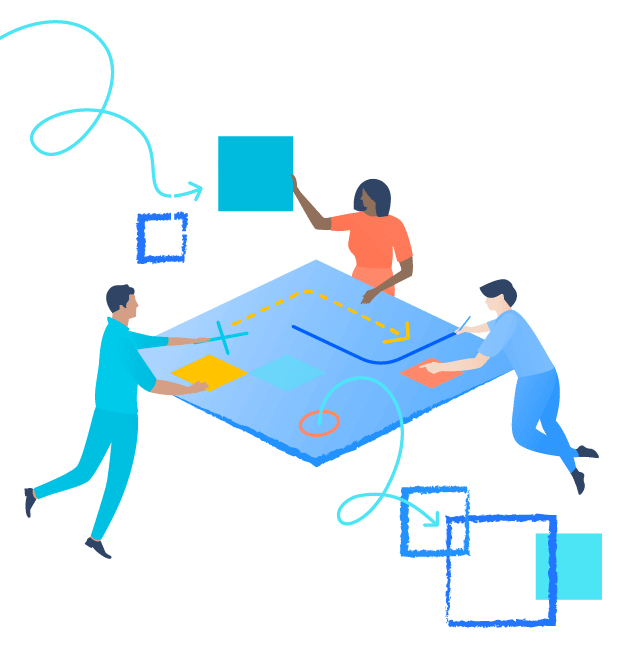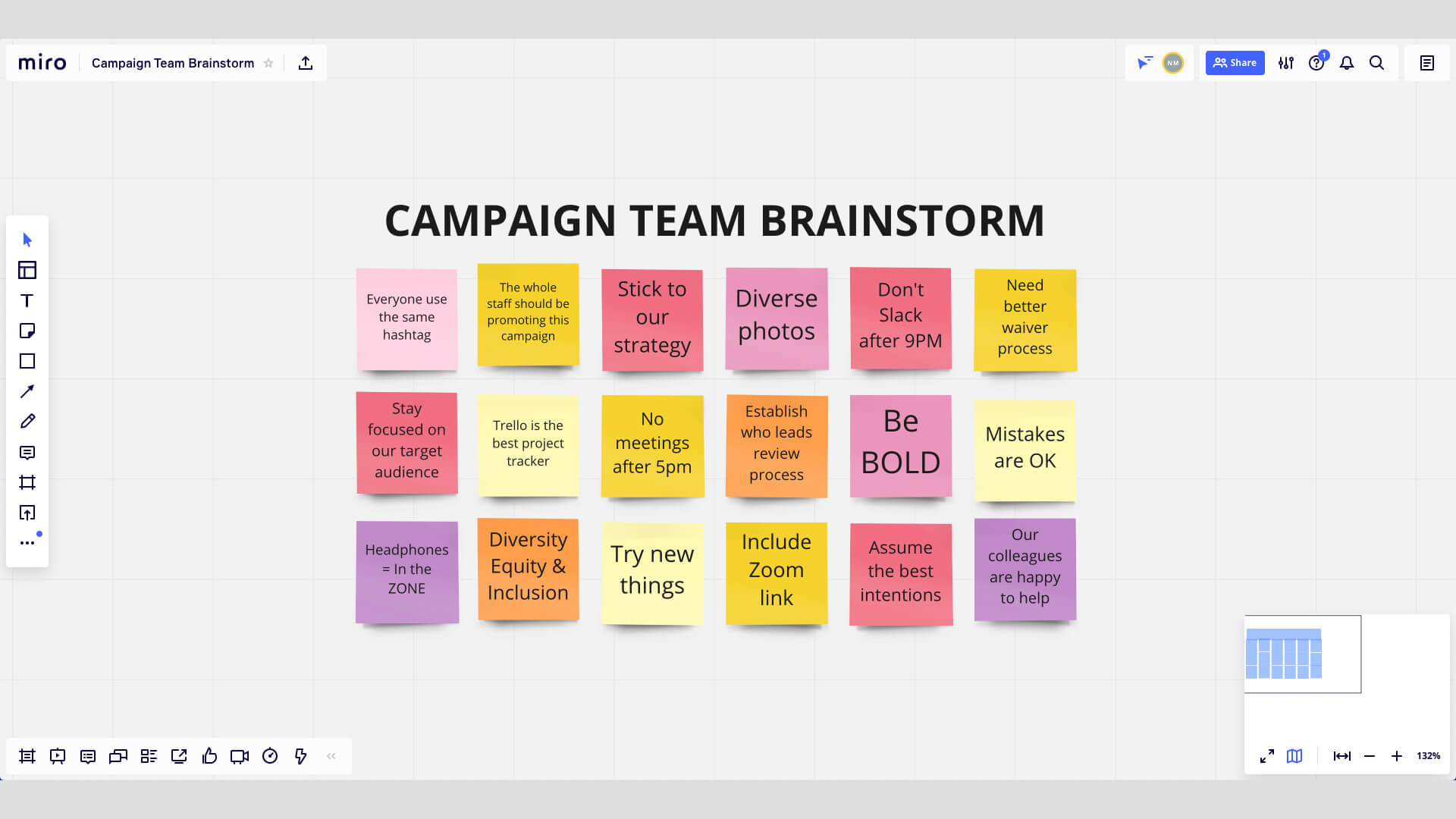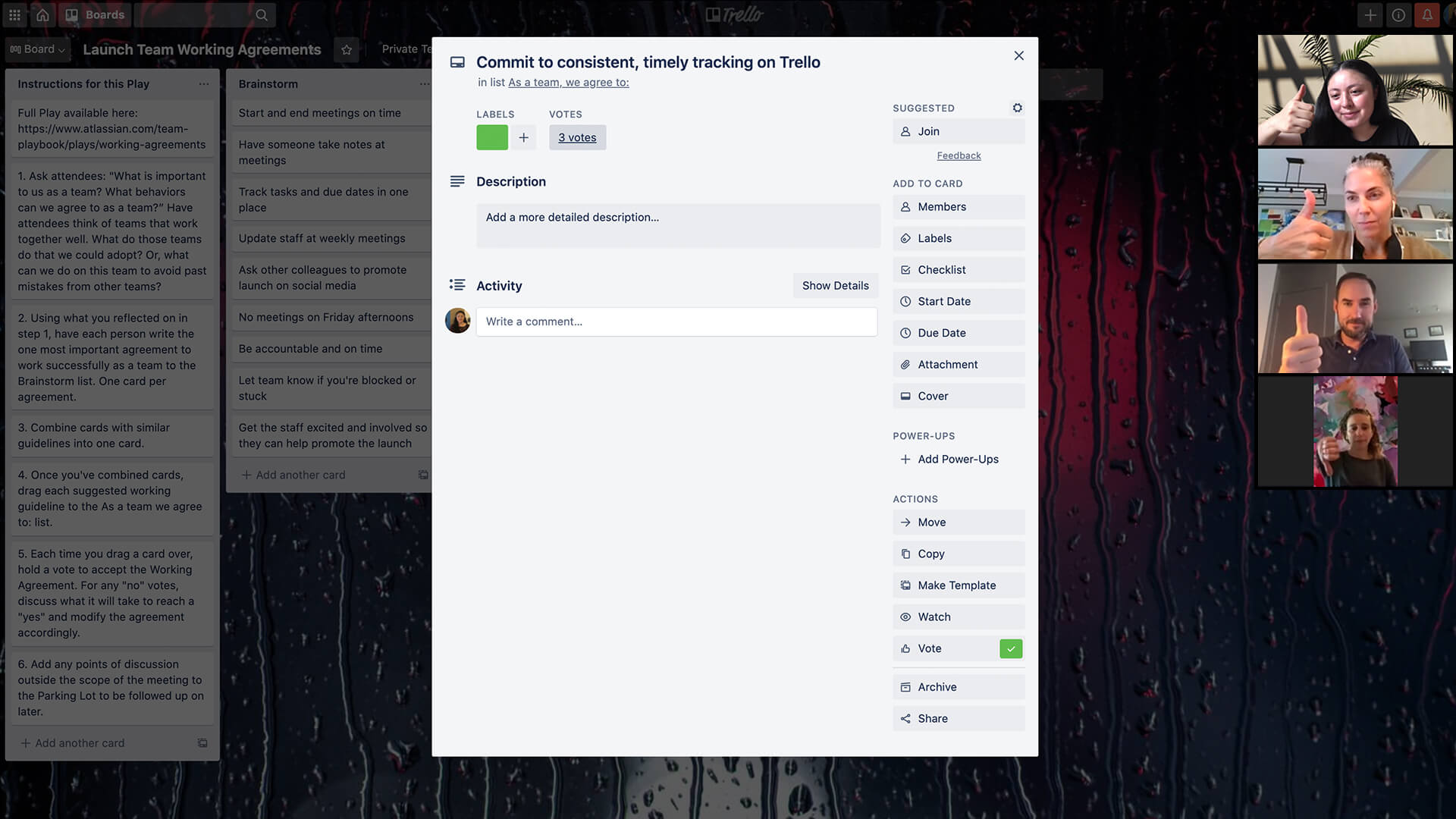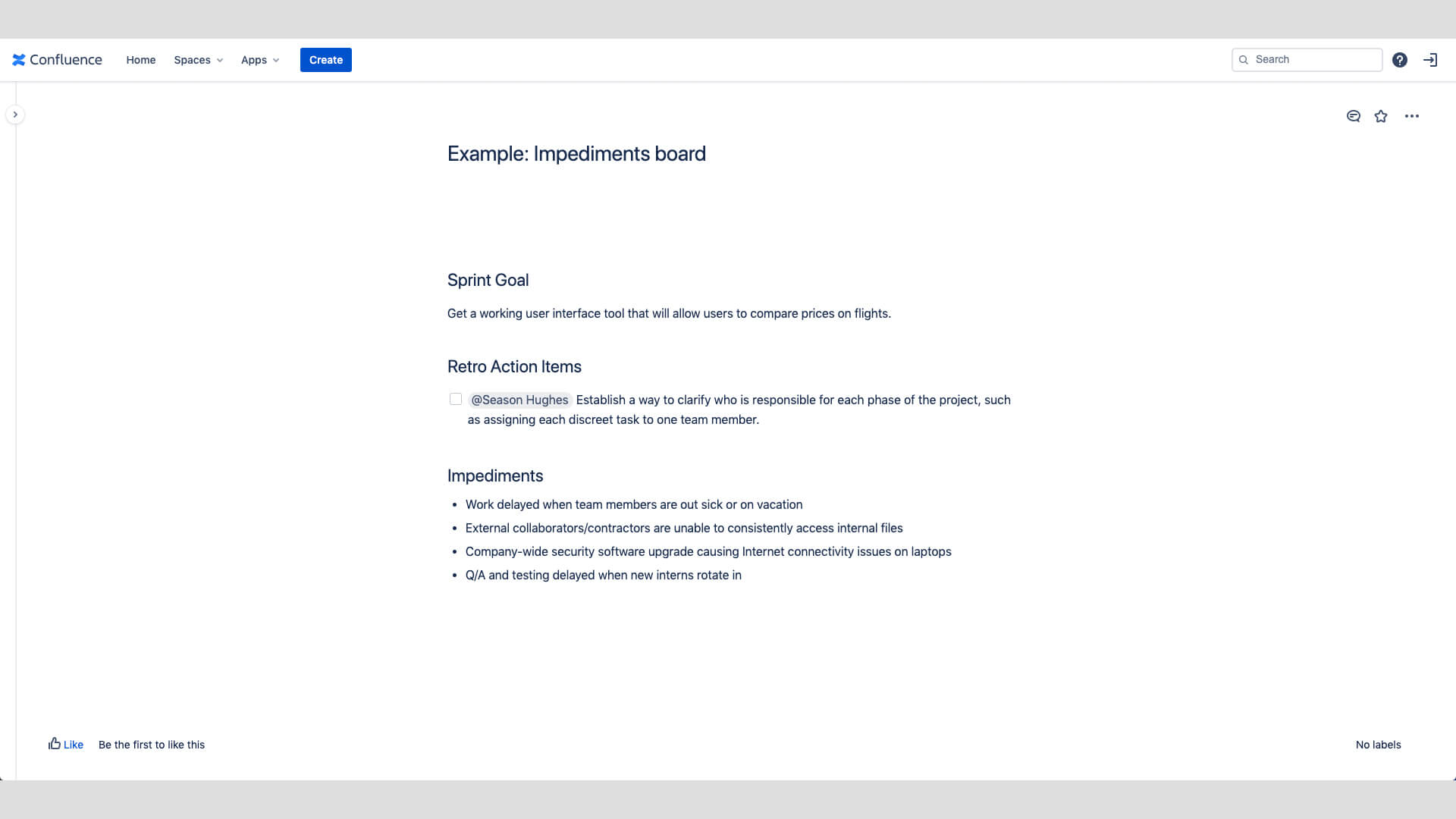Accords de coopération en action
Ces développeurs de logiciels discutent de leurs accords de coopération sur Zoom et utilisent Trello pour saisir les données.
Une équipe de campagne travaillant à distance réalise un brainstorming, vote les accords de coopération pour lesquels elle s'engagera et saisit les données dans Confluence.
Le scénario d'accord de coopération d'une équipe de collecte de fonds terminé
Ce dont vous aurez besoin
À distance
Vidéoconférence avec partage d'écran
Outil de collaboration digitale (voir les modèles)
En personne
Espace de réunion
Tableau blanc ou grande feuille de papier
Outil de collaboration digitale (voir les modèles)
Marqueurs
Post-its
Modèles facultatifs
Modèles Atlassian
Instructions pour exécuter ce scénario
1. Préparation 5 min
Il s'agit d'un scénario en trois parties. Dans les étapes ci-dessous, nous allons détailler chacune de ces parties. L'objectif est de se concentrer sur la manière dont votre équipe va réussir à travailler ensemble, sans passer des heures en réunion !
- L'équipe : Complète et passe en revue le travail préparatoire de manière asynchrone.
- Le chef d'équipe : Se prépare à donner le ton.
- Tous : Se mettent d'accord et s'engagent à aborder les sujets de discussion lors d'un atelier en direct.
Commencez par créer un document collaboratif, comme un tableau Trello ou une page Confluence. Vous pouvez utiliser les modèles mentionnés ci-dessus pour des réunions en personne ou à distance. En option, si vous travaillez sur ce scénario en personne, le fait de présenter vos concepts sur un tableau blanc peut améliorer la collaboration. Assurez-vous simplement de documenter les résultats pour pouvoir vous y référer ultérieurement.
2. Préparation de l'équipe 5 min
Envoyez le modèle aux membres de votre équipe avant l'atelier en direct. Expliquez le contexte des accords de coopération et l'importance qu'ils revêtent pour la réussite d'une équipe. Veillez à indiquer que le document est un brouillon ou un travail en cours. Envoyez votre affiche d'équipe pour que chaque membre de l'équipe comprenne ce que vous accomplissez ensemble et pourquoi. Vous ne comprenez pas encore très bien le but et les objectifs de votre équipe ? Commencez par lancer le scénario Affiche d'équipe.
Demandez aux membres de votre équipe de partager les informations suivantes :
- Nom
- Lieu de travail et fuseau horaire
- Heures de travail et engagements
- Environnement de travail et préférences
- Comment j'aime recevoir du feedback
- À propos de moi. Limitez-vous à un ou deux points pour cet exercice. Pour obtenir des points bonus, encouragez les membres de l'équipe à créer un lien vers leur guide des préférences pour en savoir plus sur leur façon de travailler.
CONSEIL : CRÉEZ VOTRE GUIDE DES PRÉFÉRENCES
Un excellent moyen d'aider les nouveaux membres de l'équipe, les sous-traitants, les équipes de projet, les parties prenantes et les équipes de réseau à s'intégrer rapidement dans votre équipe est de rédiger un guide des préférences qui explique comment vous aimez travailler.
CONSEIL : COMMENT GÉRER LES FUSEAUX HORAIRES ?
Vous avez une équipe distribuée qui travaille sur plusieurs fuseaux horaires ? Vous pouvez définir des fenêtres de collaboration afin de déterminer ensemble les heures qui conviennent le mieux aux activités synchrones
3. Préparation du chef d'équipe 10 min
Avant l'atelier en direct, demandez au chef d'équipe de faire une première tentative en consultant les deux sections suivantes du modèle.
Canaux de communication
Réfléchissez à la manière dont votre équipe va communiquer efficacement. Indiquez le canal, son objectif, le public et les normes établies en matière de communication dans cet espace. Par exemple, vous pouvez utiliser Confluence pour la documentation liée à la source de référence officielle d'un projet, et Slack comme espace de communication quotidien pour votre équipe.
Processus de remontée
Une bonne équipe sait que l'absence de planification est synonyme d'échec. Réfléchissez à la manière dont vous souhaitez que l'équipe fasse remonter l'information lorsqu'un problème urgent ne fait pas l'objet d'un consensus. Indiquez qui est le décideur, la manière dont vous traiterez une remontée, le niveau de transparence que vous fournirez et la manière dont vous informerez les autres de la décision.
Vous n'êtes pas sûr de savoir comment traiter les remontées ? Essayez notre modèle de framework décisionnel DACI. Vous pouvez également travailler avec votre équipe pour proposer un processus de remontées propres qui définira les options de remontée et qui permettra de prendre de meilleures décisions.
4. Préparez le terrain 5 min
Ouvrez la réunion en expliquant à l'équipe qu'en tant que groupe, vous créez un ensemble d'accords comportementaux pour bien collaborer.
Demandez à l'équipe :
- garder un esprit ouvert et curieux ;
- pratiquer une écoute active et d'encourager tout le monde à contribuer ;
- Minimisez les distractions et maximisez la connexion : téléphones éteints, webcams allumées et mode « Ne pas déranger » activé
- ne pas interrompre ou dominer la conversation.
- Ces règles pourront être modifiées à l'avenir en fonction de l'évolution de la situation
Passez cinq minutes à lire en silence, en équipe, l'ébauche de document préparée à l'avance. Les membres de l'équipe peuvent pendant ce temps faire des commentaires sur la page. Commencez la discussion en demandant à chacun de partager une chose qu'il a apprise sur un autre membre de l'équipe.
CONSEIL : PRIVILÉGIEZ LES PERSONNES AUX PROCESSUS
Ce scénario aborde la question de travailler ensemble en tant que personnes. Si des idées concernant la gestion du travail se présentent, telles que la documentation des processus techniques ou du workflow de la gestion de projet, remettez l'équipe sur la bonne voie et prévoyez un moment pour discuter des processus spécifiques de gestion des tâches pour les membres de l'équipe concernés.
5. Établissez des canaux de communication 10 min
Prends dix minutes pour discuter de la section sur les canaux de communication avec l'équipe.
Pistes de réflexion pour la discussion :
- Des ajouts, des suppressions ou des changements ?
- À quel moment faudra-t-il vérifier si cela fonctionne ?
- Comment voulons-nous que les autres équipes, chefs d'équipe ou parties prenantes communiquent avec nous ?
CONSEIL : TROUVER UN COMPROMIS, PAS UN CONSENSUS
Vous avez du mal à vous mettre d'accord sur la meilleure façon d'obtenir des résultats en équipe ? Les membres de l'équipe préfèrent souvent des méthodes différentes : un membre de l'équipe peut préférer utiliser Slack, tandis qu'un autre préfère passer un appel Zoom en direct. Utilise le vote pour trouver un compromis acceptable à essayer en équipe, avec la promesse que vous ne l'oublierez pas ! Vous apprendrez et vous améliorerez en tant qu'équipe au fil du temps.
6. Organisez des réunions 30 min
Remplissez la section consacrée aux réunions. Partez du principe général selon lequel le temps de concentration est précieux. Pour faire avancer les choses, certaines règles peuvent s'appliquer : il est préférable d'organiser moins de réunions et d'optimiser les communications asynchrones par rapport aux communications synchrones. Envie de découvrir comment vous pouvez faire évoluer la culture de réunion de votre entreprise ? Commencez par suivre notre cours Comment organiser des réunions efficaces.
Pistes de réflexion pour la discussion :
- Quels sont les objectifs et les résultats souhaités ?
- Quel format de réunion souhaitons-nous privilégier ?
- Qui participe aux réunions ? Quels sont leurs rôles et leurs équipes ?
- De quels supports et outils avons-nous besoin ?
- Comment devons-nous nous présenter ?
- Comment allons-nous gérer le suivi ?
- À quel moment faudra-t-il vérifier si cela fonctionne ?
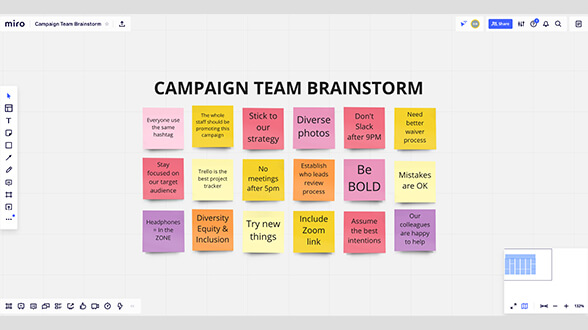
EXEMPLE : IDÉES
Voici un exemple de brainstorming d'équipe sur les réunions.
Vous pouvez constater que les idées vont des produits aux comportements en passant par l'amélioration des processus.
7. Gestion des remontées 10 min
Examinez ensemble la section relative au processus de remontée. En équipe, discutez des actions que vous allez entreprendre et engagez-vous à prendre une décision. Assurez-vous que toute l'équipe est d'accord.
8. Amélioration continue 10 min
L'une des choses les plus importantes à aborder en tant qu'équipe est de planifier pour apprendre et s'adapter ensemble. Discutez des rituels et des normes de communication.
Pistes de réflexion pour la discussion :
- Partagez du feedback
- Enseignements
- Célébrez votre réussite
- Étapes importantes personnelles
Suivi
Réexaminez régulièrement
Réexaminez périodiquement les accords de coopération de votre équipe, surtout lorsque de nouveaux membres intègrent l'équipe, lors de réorganisations d'équipe, lorsque les scénarios de travail changent ou qu'un accord ne peut plus être respecté. C'est particulièrement important si votre équipe était autrefois composée de personnes travaillant au bureau et est devenue hybride ou totalement distante. Vos rituels et accords devront être modifiés pour s'adapter aux différentes zones géographiques, aux fuseaux horaires et à la technologie.
Passez-les en revue et votez pour conserver ou modifier les accords existants. Demandez ensuite aux membres de l'équipe de mener un brainstorming, de proposer et de voter pour l'ajout de tout accord supplémentaire.
Si un accord ne peut être respecté, discutez de ce qui peut faire obstacle.
Comme toute ligne directrice, les accords de coopération sont comme un muscle qui doit être flexible. Répétez souvent les accords et épinglez le lien sur la page de votre équipe dans Atlas, en encourageant les membres de l'équipe à les consulter tous les trimestres. Gardez cette documentation accessible et présente à l'esprit lors de tous les projets majeurs ou en cas de conflit.
Variations
Réflexions
Testez votre accord de coopération en le soumettant à une série de réflexions :
- Pensez aux équipes qui collaborent bien. Que font ces équipes que nous pourrions adopter ?
- Que pouvons-nous faire dans cette équipe pour éviter les erreurs passées des autres équipes ?
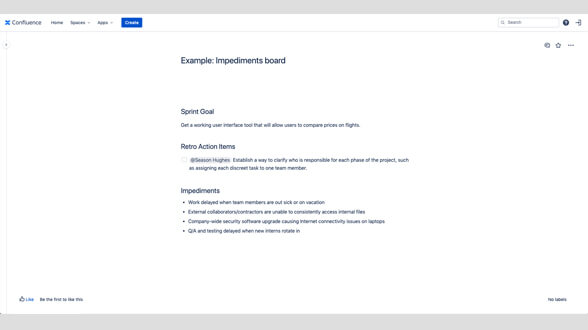
EXEMPLE : TABLEAU DES OBSTACLES
Voici comment une équipe a documenté ses défis dans un tableau des obstacles.
Commencez par les défis
Avant la session sur les accords de coopération, rassemblez les problèmes auxquels l'équipe est actuellement confrontée dans un tableau des obstacles (voir exemple), une rétrospective ou simplement des défis connus. Apportez-les et partagez-les lors de la session afin qu'ils puissent documenter les accords de coopération.
Scénarios connexes
De notre équipe, pour la vôtre
Tenez-vous informé des derniers scénarios et des trucs et astuces grâce à notre newsletter mensuelle.

